Reaching The Coast
Standing beside the Mediterranean after a monster journey from Carlisle at the other end of the European continent, we spy a railway line. The year is 1952, the location is near Málaga on the southern coast of Andalusia. According to the distances from Central Madrid’s Puerta del Sol, Iberia’s Rome or Charing Cross of such things, we have travelled 295 miles on National Road 1 and perhaps another 400 miles further south, mainly on National Road 4. A total of almost 700 miles, and that’s just in Spain. Prior to that, my father and grandparents travelled the length of England, from Carlisle to Dover, across the channel and then down the west of France to Biarritz and on to the border at Irun.
Added to which, because exchange controls were in place at the time, this was achieved with no more than the £25 that 1950s Brits were allowed to take out of the UK. Upon reflection, as they have to return, on less than £12 and 10/-. At £2 a litre, you wouldn’t venture far these days. Or should that be £10 an almud? Explanation to follow.
Thirty years later and forty years before the present day, I’d ventured south too. At 21 years old I was the same age as my father had been when set off on his big adventure with his parents. Puffins will have realised by now that I prefer to travel by rail which, in this case, diverges from the road. Avoiding the worst of the mountains, the iron road heads west to Cordoba before striking south for the sea. Therefore, I must bow to the intrepid Ford 8 voyagers and glean what I can from their photos.
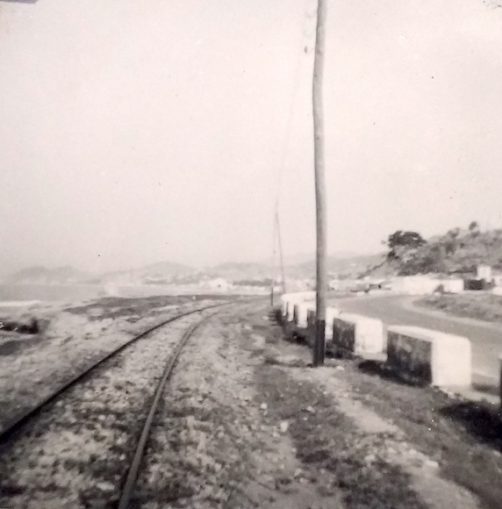
© Always Worth Saying 2022, Going Postal
Recently one of my sons, also in his 21st year, would follow in that family tradition and strike out for Spain. Unfortunately, the old ways are not good enough for the young. Not for them L’Aquitaine from Gare d’Austerlitz one Paris evening to connect with a sleeper at the border that promised a weekend in Madrid lodgings run by an order of nuns. A 400-mile drive to Dover, culminating in your car being placed on the deck of a boat by a crane, doesn’t appeal either. As for family-owned hotels in Biarritz and stopping for water at wells in places like Boceguillas, it fails to register with Generation 2022.
Likewise, rather than go with his parents or an American girl desperate for a ‘doing Europe’ buddy after warring with her sister, he would journey with his matez. Yuk. And fly by EasyBudgetWizzJet.com to stay in a Premier Inn Lodge suite in a wall of concrete amongst other walls of concrete. I must admit, dear Puffin, rather than be disappointed for him, I did feel somewhat smug (and I’m sure my ancestors did too) when, because his vaccination app was upside and the wrong way around, he went precisely nowhere. *sniggers*
Unsurprisingly, 70 years after the old photo was taken, a superhighway has been laid and blasted where the railway and coast road once were. But more than a hint of the old line is visible to the careful observer. Via Street View, the background hills line up well and a tunnel sits to the left which one suspects will have been the railway line.
As the new highway goes through a cutting, one supposes the old road zig-zagged up and down the rugged coastline while the train enjoyed a necessary gentler gradient closer to the beach and through tunnels when unavoidable. On the other side of the cutting and down a slip road, we’re closer to the view of the original crescent landscape, with Málaga in the middle and the two distinctive hills to the left. The path on the right of the wooden fence is likely the track bed of the old railway line. An avenue called Ave Salvador follows the coast but becomes built up, making following the route of the old railway difficult. The sea has been developed too, with yacht moorings such as the Marina Málaga Ahoy encroaching on the Med.
A Note on Measurements
Glancing at the old photo, the rails look much closer together than the 5ft 5 and 21/32nds of an inch which constitutes the standard Spanish railway gauge. Not quite a round number, 5ft 5 and 21/32nds of an inch sounds a strange gauge to choose. In metric, it would be 1668mm, not much better. A friend tells me that 5ft 5 and 21/32nds of an inch is six Castillian feet minus four millimetres. Presumably, six Castillian feet was the original Spanish gauge in the days when travelling at 20 mph rather than 200 mph meant a few millimetres hither and thither didn’t make much difference.
As we’ve seen on the long Nostalgia Album drive south, Spain was slow to develop. Lines of communication were poor. Mountains, deserts and dusty roads kept the various parts of the country remote both from each other and from the outside world. Long-distance railways, and the necessary standardisation they bring with them, were slow to arrive with La Compañía Ferrocarriles Surbanos de Málaga (FSM) not building the line from Málaga east along the coast to Vélez-Málaga until 1905 – half a century after England’s railway mania tracklaying boom.
Different parts of Spain retained their different local measurements for longer than other parts of Europe. To cause greater confusion, they often had the same names but were not quantified in the same way. An almud is 4.625 litres in mainland Spain but 5.5 litres in the Canary Islands. Rather than imperial measurement (though as we shall see they had a use in Spain’s empire) these are called Spanish customary units. The Spanish foot was a ‘pie’. A yard was a vara but in different places, varas were of different lengths. Even to the extent of a Barcelona vara being twice as long as a Balearic Islands one. In my day, a unit measured only chocolate but I can’t remember what it was called. Don’t laugh at the Spanish, old people like me can remember when we had our own imperial unit for Tato Crisps – the dram.
All of which insists me to a story about my father. If I remember rightly (and I probably don’t), in Italy the eto was a weight equivalent to 100 grammes. Seeing some sliced ham attacked to a spike announcing ETO 500 Lire, my father marched into the butchers, patiently waited his turn and then politely requested half a pound of eto from a puzzled shop girl. Another time, he dragged us on a pointless walk through streets marked with ‘Senso Unico’ signs thinking it signified the scenic route. Back in our one-star hotel, after an entire day without seeing anything particularly scenic, he enquired at reception and was informed it meant ‘one-way street’. Ah well, Brits abroad and all that.
Meanwhile, in provincial Spain in the 1950s, a million square yards (varas) was a ‘labour’. At 177 acres you’d think there wouldn’t be much use for it but in sparsely inhabited colonies to be staked, such as California and Texas, it proved useful. The square league was equivalent to 4,428 acres. Presumably handy when dividing up South America between the malaria and poison blow-pipe survivors from a boat full of conquistadors.
La Compañía Ferrocarriles Surbanos de Málaga
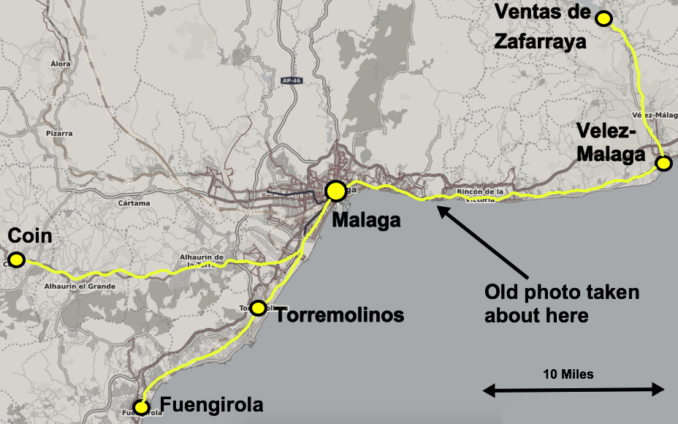
FSM Málaga,
OpenStreetMap.org and its contributors – Licence CC BY-SA 2.0
None of which concerns the FSM line from Málaga to Vélez-Málaga, other than to note that research reveals it was built to the metre gauge of three-foot and three and a third inches. My research also discovered an old timetable. Monoglots like myself have to use Google Translate to understand such things, a bonus being that station names (perhaps taking a leaf from my father’s book) are sometimes translated into an eccentric meaning. According to Translate, the line from Málaga to Vélez-Málaga, includes a stop at Victory Corner. Fair enough, a fine name akin to our own Southern Railways terminal at Waterloo. The next stop after Vélez-Málaga, is Sea Tower followed by Nice Valley. Closer to Málaga one can alight at The Cove and The Stick.
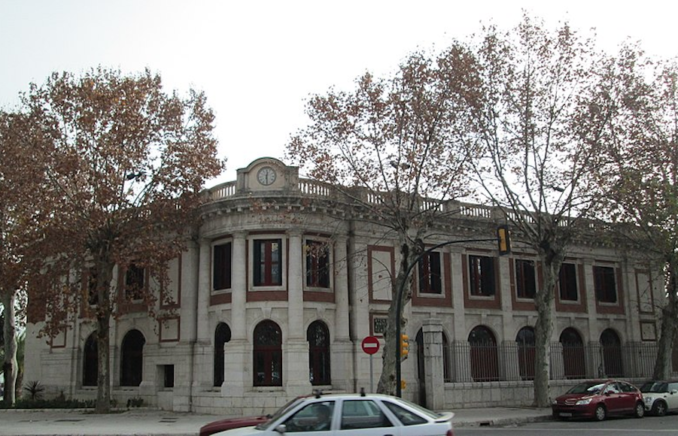
Former suburban railways station, Málaga,
Tyk – Licence CC BY-SA 2.0
From Vélez-Málaga, the line was extended north with, by 1921, Ventas de Zafarraya having been reached. Google Translate presents this as Sales of Zafarray, as if an upmarket 1970s returns catalogue. En route, Translate manages to lay track through Sugar Mill, The Romans and Slaughter. Inland from Málaga, the FSM continued to Coin, via The Dog and The Farmhouse. Westwards, again via The Dog (presumably lines diverged at The Dog Junction), another route ran all the way to Fuengirola, passing through Torremolinos on the way.
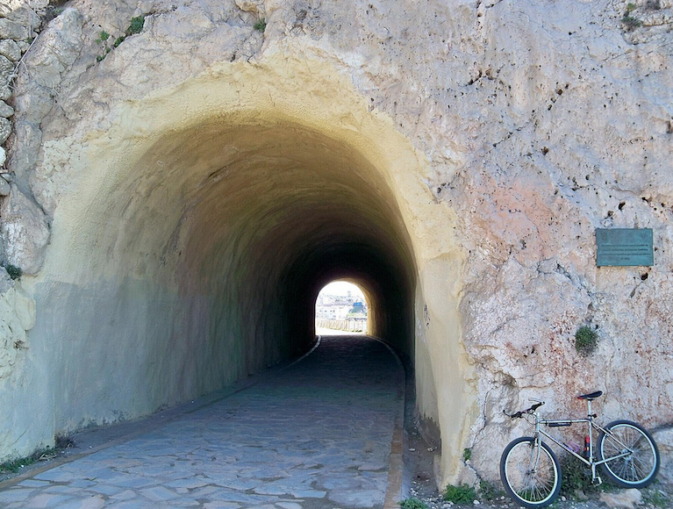
Antiguo tunnel of the Ferrocarriles Suburbanos de Málaga,
David Capilla – Licence CC BY-SA 2.0
The rest of the FSM closed in stages between 1960 and 1968 but the section between Málaga and Fuengirola survives, has been modernised and thrives with the help of a twenty-minute frequency electric service. Although unlikely to get a laugh, Torremolinos deserves a mention as it will be the next port of call in Nostalgia Album.

Former train station of Fuengirola,
tyx – Licence CC BY-SA 3.0
Torremolinos Surprise
The next photo is captioned to Torremolinos and shows an unprepossessing one-story building with a tiled roof and arched entrance. One assumed it couldn’t have survived the billion tons of concrete built upon the Andalusian coast as the Spanish economy eventually developed. Further investigation proved me wrong and provided a telling insight into the economic changes that the country was beginning to embark upon seven decades ago.
All will be explained next time on Nostalgia Album!
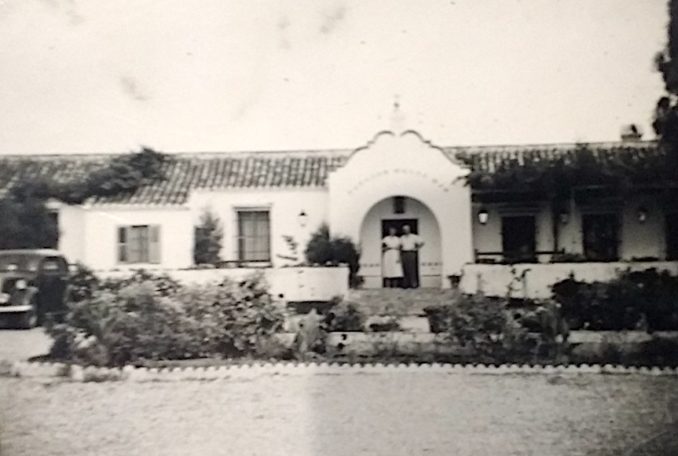
© Always Worth Saying 2022, Going Postal
© Always Worth Saying 2022



